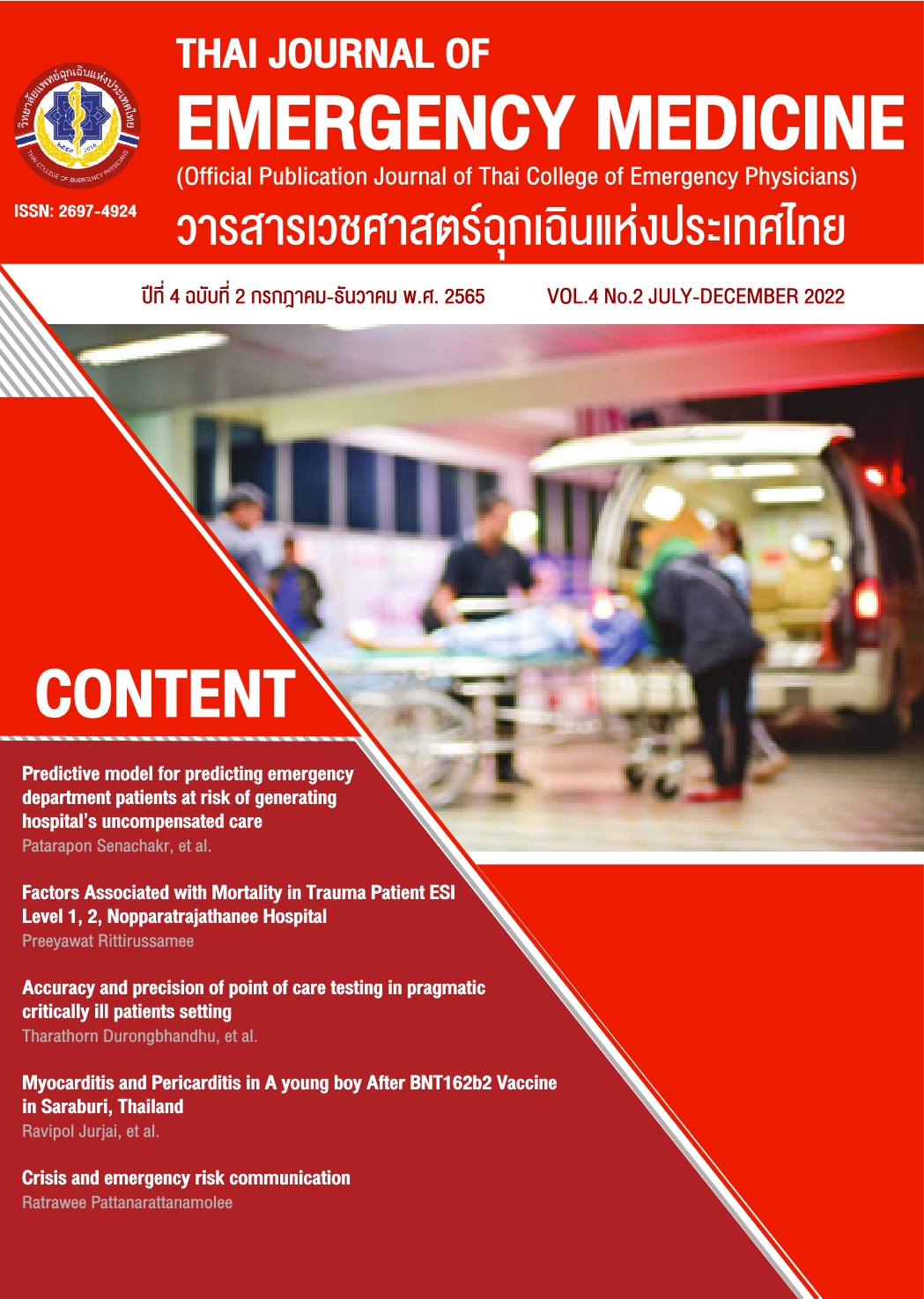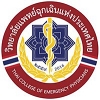Accuracy and precision of point of care testing in pragmatic critically ill patients setting
Keywords:
point of care testing, critical illnessAbstract
Introduction
Point of care testing (POCT) refers to laboratory tests performed outside of the traditional laboratory setting (Central lab). One advantage of POCT is that it can be completed quickly, and doctors can perform the tests themselves after receiving brief training. This can reduce the time needed to make treatment decisions. However, the accuracy and precision of the POCT for patients with critical illness, particularly in a real-world emergency setting, are still a matter of debate.
Objectives
To study the accuracy and precision of POCT in patients with critical illness in the emergency department
Method
Retrospective observational study collected laboratory data of emergency patients in Chonburi Hospital from 1 January-31 December 2020. The inclusion criteria were 15-year-old patients or above who had critically ill problems (e.g., cardiac arrest, shock, and sepsis) and need emergency treatment. Blood samples were analyzed by POCT (Blood Analyzer, Abbot, Cartridge CHEM8) and the central laboratory room at the same time for evaluation of Sodium (Na), Potassium (k), Bicarbonate (HCO3), Blood Urea Nitrogen (BUN), Creatine (Cr) and Hematocrit (Hct) respectively. The laboratory value from POCT and the central laboratory room were analyzed by Bland-Altman analysis (B.A. plot) and the results were presented with correlation, mean difference (MD), and level of agreement (LOA)
Results
100 patients were enrolled in the study. The majority of them were male (66%). The average age was 56.6 years with a standard deviation of 17.3%. The majority of illnesses were related to cardiac arrest (67%). POCT and the central lab’s correlation coefficients were between 0.80 and 0.94. It is a strong positive correlation. Na has MD 0.53 with LOA -7.66,8.72 mEq/L, K has MD -0.10 with LOA -2.30,2.10 mEq/L, HCO 3 has MD -3.74 with LOA -11.13, 3.65 mEq/L, BUN has MD -3.30 with LOA -27.62, 21.02 mg/dl, Cr has MD -0.26 with LOA -1.20, 0.68 mg/dl and Hct has MD -0.56 with LOA -10.30,9.18% respectively. K had the lowest MD that lines between its LOA, it was only 93% of the total MD.
Conclusion
POCT strongly correlated with the Central lab. But assessing by agreement with the central lab, POCT reveals good accuracy, but poor precision, especially K, HCO 3 , and Hct. So, Critically ill patients’ treatment decisions should be based mainly on their clinical information.
References
Nichols JH. Point of care testing. Clin Lab Med 2007;27(4):893-908. doi: 10.1016/j.cll.2007.07.003.
Pidetcha P, Ornvichian S, Chalachiva S. Accuracy and precision of the i-STAT portable clinical analyzer: an analytical point of view. J Med Assoc Thai 2000 Apr;83:445-50. PMID: 10808706.
Goldstein, L.N., Wells, M. & Vincent-Lambert, C. The cost-effectiveness of upfront point-ofcare testing in the emergency department: a secondary analysis of a randomized, controlled trial. Scand J Trauma Resusc Emerg Med 2019. doi:10.1186/s13049-019-0687-2
Goyal M, Pines JM, Drumheller BC, Gaieski DF. Point-of-care testing at triage decreases time to lactate level in septic patients. J Emerg Med 2010;38:578-81. doi: 10.1016/j.jemermed.2007.11.099.
Singer AJ, Thode HC Jr, Viccellio P, Pines JM. The association between length of emergency department boarding and mortality. Acad Emerg Med 2011;18:1324-9. doi: 10.1111/j.1553-2712.2011.01236.x.
Sun BC, Hsia RY, Weiss RE, Zingmond D, Liang LJ, Han W, et al. Effect of emergency department crowding on outcomes of admitted patients. Ann Emerg Med 2013;61:605-11.e6. doi: 10.1016/j.annemergmed.2012.10.026
Rooney KD, Schilling UM. Point-of-care testing in the overcrowded emergency department--can it make a difference? Crit Care 2014;18:692. doi: 10.1186/s13054-014-0692-9..
Alter DN. Point-of-Care Testing for the Emergency Department Patient: Quantity and Quality of the Available Evidence. Arch Pathol Lab Med 2021;145:308-19. doi: 10.5858/arpa.2020-0495-RA.
Rajsic S, Breitkopf R, Bachler M, Treml B. Diagnostic Modalities in Critical Care: Point-of-Care Approach. Diagnostics (Basel) 2021;11:2202. doi:10.3390/diagnostics11122202..
Steinfelder-Visscher J, Teerenstra S, Gunnewiek JM, Weerwind PW. Evaluation of the i-STAT point-of-care analyzer in critically ill adult patients. J Extra Corpor Technol 2008;40:57-60. PMID: 18389666
Chacko B, Peter JV, Patole S, Fleming JJ, Selvakumar R. Electrolytes assessed by point-of-care testing - Are the values comparable with results obtained from the central laboratory? Indian J Crit Care Med. 2011 Jan;15(1):24-9. doi: 10.4103/0972-5229.78219.
Gravala A, Myrianthes P. Comparison of point of care versus central laboratory measurements of hematocrit, hemoglobin and electrolyte concentrations. Heart lung 2017;46:246-50
Bland M. Sample size for a study of agreement between two methods of measurement[Internet].2004[cited 2021 Jan 1]. Available from: https://www-users.york.ac.uk/~mb55/meas/sizemeth.htm
Abbot corporation. I-stat CHEM8+ cartridge [Internet].2018[cited 2021 Jan 1].Available from: https://www.globalpointofcare.abbott/en/product-details/apoc/istat-chem8.html
Giavarina D. Understanding Bland Altman analysis. Biochem Med (Zagreb) 2015;25:141- 51. doi: 10.11613/BM.2015.015.
Purdal S. Accuracy, precision, validity and reliability[internet].2013[cited 2021 Jan 1]. Available from: https://communitymedicine- 4all.com/2015/06/23/accuracy-precision-validity-and-reliability/
Mirzazadeh M, Morovat A, James T, Smith I, Kirby J, Shine B. Point-of-care testing of electrolytes and calcium using blood gas analyzers: it is time we trusted the results. Emerg Med J. 2016 Mar;33(3):181-6. doi: 10.1136/emermed-2015-204669.
Hohmann C, Pfister R, Kuhr K, Merkle J, Hinzmann J, Miches G. Determination of electrolytes in critical illness patients at different ph ranges: Whom shall we believe, the blood gas analysis or the laboratory autoanalyzer?. Crit Care Res Pract 2019. doi:10.1155/2019/9838706
Chaisirin W, Wongkrajang P, Thoesam T, Praphruetkit N, Nakornchai T, Riyapan S, et al. Role of Point-of-Care Testing in Reducing Time to Treatment Decision-Making in Urgency Patients: A Randomized Controlled Trial. West J Emerg Med 2020;21:404-410. doi: 10.5811/westjem.2019.10.43655.
Downloads
Published
How to Cite
Issue
Section
Categories
License
Copyright (c) 2023 Thai Collage of Emergency Physicians

This work is licensed under a Creative Commons Attribution-NonCommercial-NoDerivatives 4.0 International License.
บทความที่ได้รับตีพิมพ์ในวารสารเวชศาสตร์ฉุกเฉินแห่งประเทศไทย ถือเป็นเป็นลิขสิทธิ์ของ วิทยาลัยแพทย์เวชศาสตร์ฉุกเฉินแห่งประเทศไทย
กรณีที่บทความได้รับการตีพิมพ์ในวารสารเวชศาสตร์ฉุกเฉินแห่งประเทศไทยแล้ว จะตีพิมพ์ในรูปแบบอิเล็กทรอนิกส์ ไม่มีสำเนาการพิมพ์ภายหลังหนังสือเผยแพร่เรียบร้อยแล้ว ผู้นิพนธ์ไม่สามารถนำบทความดังกล่าวไปนำเสนอหรือตีพิมพ์ในรูปแบบใดๆ ที่อื่นได้ หากมิได้รับคำอนุญาตจากวารสารเวชศาสตร์ฉุกเฉินแห่งประเทศไทย




